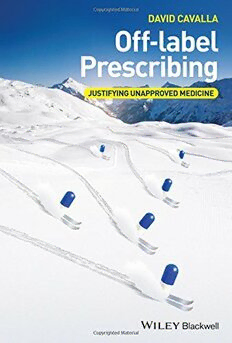Table Of ContentOff-label prescribing – justifying
unapproved medicine
Off-label
prescribing –
justifying
unapproved
medicine
David Cavalla
This edition first published 2015 © 2015 by John Wiley & Sons, Ltd.
Registered Office
John Wiley & Sons, Ltd., The Atrium, Southern Gate, Chichester, West Sussex,
PO19 8SQ, UK
Editorial Offices
9600 Garsington Road, Oxford, OX4 2DQ, UK
The Atrium, Southern Gate, Chichester, West Sussex, PO19 8SQ, UK
111 River Street, Hoboken, NJ 07030-5774, USA
For details of our global editorial offices, for customer services and for information about how to apply
for permission to reuse the copyright material in this book please see our website at
www.wiley.com/wiley-blackwell.
The right of the author to be identified as the author of this work has been asserted in accordance with the
UK Copyright, Designs and Patents Act 1988.
All rights reserved. No part of this publication may be reproduced, stored in a retrieval system, or
transmitted, in any form or by any means, electronic, mechanical, photocopying, recording or otherwise,
except as permitted by the UK Copyright, Designs and Patents Act 1988, without the prior permission of
the publisher.
Designations used by companies to distinguish their products are often claimed as trademarks. All brand
names and product names used in this book are trade names, service marks, trademarks or registered
trademarks of their respective owners. The publisher is not associated with any product or vendor
mentioned in this book.
Limit of Liability/Disclaimer of Warranty: While the publisher and author(s) have used their best
efforts in preparing this book, they make no representations or warranties with respect to the accuracy
or completeness of the contents of this book and specifically disclaim any implied warranties of
merchantability or fitness for a particular purpose. It is sold on the understanding that the publisher is
not engaged in rendering professional services and neither the publisher nor the author shall be liable for
damages arising herefrom. If professional advice or other expert assistance is required, the services of a
competent professional should be sought.
Library of Congress Cataloging-in-Publication Data
Cavalla, David, author.
Off-label prescribing : justifying unapproved medicine / David Cavalla.
p. ; cm.
Includes bibliographical references and index.
ISBN 978-1-118-91207-2 (cloth)
I. Title.
[DNLM: 1. Off-Label Use. 2. Drug Approval. 3. Pharmaceutical Preparations. QV 748]
RM300
615.1–dc23
2014028488
A catalogue record for this book is available from the British Library.
Wiley also publishes its books in a variety of electronic formats. Some content that appears in print may not
be available in electronic books.
Cover image: © Dan Jubb
Cover design by Dan Jubb
Set in 9/11pt Meridien by SPi Publisher Services, Pondicherry, India
1 2015
This book is for patients, who for too long have been misled about the fact that
many of the prescriptions that are written for them are for unapproved for their
circumstance. We are all patients, or potential patients, so really this book is for
everyone.
Contents
Foreword, ix
Acknowledgement, xi
Author’s note on the cover design, xiii
Introduction, xv
1 What is off-label medication, and how prevalent is it?, 1
What is ‘off-label’ medicine?, 2
Scope of the issue, 8
2 Where it all went right: new uses for existing drugs supported by good
evidence, 19
Examples where products have been through regulatory approval
for a secondary use, 19
Finasteride: pseudohermaphroditism and hair growth, 19
Sildenafil: re-tasking the blue pill for a life-threatening illness, 21
Doxycycline: from killing bugs to protecting gums, 22
Raloxifene: from cancer to bone disease and back again, 23
Galantamine: using snowdrops to improve memory, 24
Cyclosporine: preventing immune attack on organs and skin, 25
Dimethyl fumarate: a remarkable drug for multiple sclerosis, 26
Botox: a drug to kill or cure you, 27
Examples where evidence is uncertain and not to regulatory standards, 28
Tricyclic antidepressants: for curing more than emotional pain, 28
Aspirin for cancer, 30
Retrospective data: looking back to create future therapies, 30
3 Shared decision making and consent, 33
Viewpoint of the patient, 34
Viewpoint of the prescriber, 37
Professional guidelines, 38
Patient awareness, 41
Practitioner attitudes, 41
Diagnosis, 44
4 Gaming the system: the role of the pharmaceutical industry, 47
Normal drug development and drug repurposing development, 48
Gaming the system, 53
Orphan use, 56
Pharmaceutical marketing, 61
Expanding uses for non-pharmaceuticals, 64
DTC advertising, 64
Patents and genericisation, 65
Conclusion, 68
5 Do no harm: Safety and efficacy, 71
Relative safety, 73
vii
viii Contents
Different therapeutic uses, 73
Chronic versus acute dosing, 78
Different dose, 81
Differences between children and adults, 82
Other patient populations, 86
Fatal ADRs, 87
Quality of evidence, 88
Strong evidence, 89
Poor evidence, 91
Doctors do not know evidence, 94
Proximity of off-label to on-label, 96
Debunking medical myths, 101
6 Liability, injustice and reimbursement: who should pay?, 105
A prescriber’s ethical and professional duties, 105
Medical professional participation in off-label promotion, 105
A prescriber’s legal position, 106
Consent, 106
Liability, 111
Reimbursement, 113
Compendia, 115
NICE, 117
Compassionate access, 120
Cost, as a driver for off-label medicine, 121
7 The role of regulation in off-label medicine, 125
Regulators do not regulate medical practice, 126
Off-label marketing, 128
Off-label fines, 130
Whistle-blowers, 134
European situation, 134
Tip of the iceberg, 136
Free speech, 138
8 Justifying unapproved medicine, 143
Constraints on making changes, 144
Moves to enhance off-label medicine, 145
Diagnosis shifting, 146
A partial solution: clinical trial transparency, 147
A solution based on increased regulatory supervision, 152
My solutions, 153
Professional standards, 153
Reimbursement and pricing, 156
Outcomes, 159
Conclusion, 173
References, 175
Index, 191

